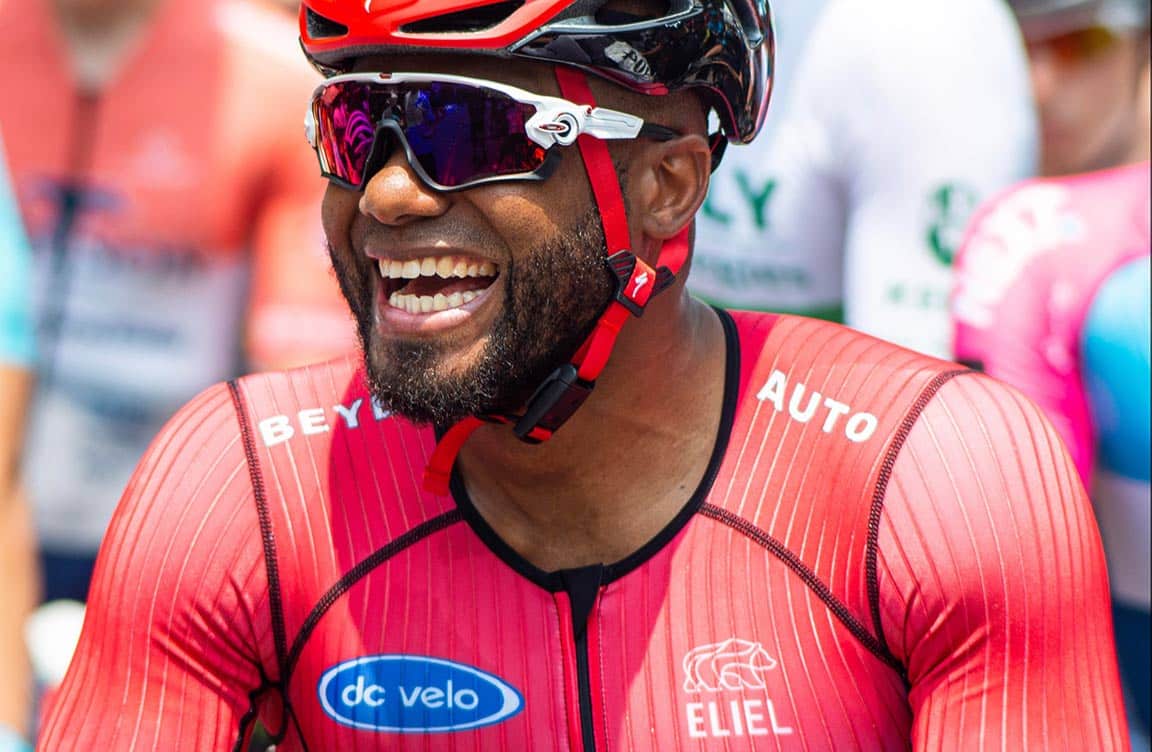
How This Cyclist Raised His FTP 35 Watts and 60-Minute Power by 50 Watts!
By Chris Carmichael, with data from Coach Adam Pulford
Athletes often specialize in disciplines that favor their strengths. In cycling, some beginners recognize they have an aptitude for sprinting, or climbing, or time trialing, and that’s the aspect of the sport they focus on intently. They become “sprinters”, “climbers”, and “time trial specialists”. It makes sense to develop your strengths, and it’s a lot of fun when your passion aligns with your talent. But it can also become a prison, progressively diminishing your opportunities for success. If you’re a sprinter, the finish has to be a sprint. This was the challenge for Washington D.C. cyclist and police officer, DJ Brew. Here’s how he transformed his fitness, nutrition, and mentality to become a rider with more opportunities to win!
The Starting Point
DJ Brew races Pro/1 on the DC Velo Racing Team and has been a regular on the local group ride and race scene in Washington DC and surrounding areas. A true time-crunched cyclist, he is a father, husband, and works long hours as a Maryland-National Capital Park Police officer. More than 10 years ago he started racing as a Category 5, progressing to Category 3 within a year and Category 1 the following year. Competing primarily in criteriums and supplementing his training with fast, competitive group rides, DJ’s developed a reputation for having an explosive sprint.
“Before I started working with him, we had about a year of battling together on local group rides and I could never hold a flame to his sprint,” said his CTS Coach Adam Pulford. “He could blast off from 100-500m and win anything if it got that close. But, other racers could identify that strength and develop a strategy to beat him, so we needed to develop ours, and that was to change his riding style and physiology to win in multiple ways: from solo breakaways, catching breaks, group sprints, or even short climbs.”
The Transformation, by the numbers
During 2020, DJ’s power at lactate threshold increased 35 Watts and he lost 12 pounds (5.5kg), which increased his 20-minute power-to-weight ratio by 12% (4.36W/kg to 4.83W/kg).
Even more important, he increased how long he could maintain high power outputs. His time-to-exhaustion (TTE) at lactate threshold power doubled and his 60-minute power output increased from 301W to 354W. And through it all, he maintained and even increased his capacity for explosive finishes. His peak sprinting power (10-15 seconds) was about 1450W and increased to 1560W, which makes an even bigger difference in performance when you take the weight loss into account.
How He Did It
DJ’s impressive transformation into a threat to win a lot more than just flat criteriums was not just the result of a new training plan. Placing his trust in Coach Adam, he made changes to his workouts, eating and recovery habits, and his mental preparation.
“He looked at all of my past data and pretty much had me figured out on day one!” said Brew. “Because we were both starting off on the same page I was able to fully put all of my trust in him. I knew it would make me a more versatile racer, which in turn would allow me to have more fun during racing. It’s always more fun when you can have multiple ways to win!”
Training Interventions
Longer intervals at aerobic endurance (Low Tempo and Tempo) and lactate threshold were the biggest changes to DJ’s training strategy, as well as increasing the density of these workouts within training blocks. This necessitated a decrease in the time spent at very high intensities, which was made easier by the fact most group rides and races were cancelled in 2020. This also increased his Chronic Training Load (CTL) more than any other year on record. And while fitness is important, performance is what wins races. You can see in the Performance Management Chart below the period where CTL peaked then decreased as his FTP, VO2, and Sprint performances came through:
Developing the power to hold a higher “all day” pace, which is also the ability to sit in and conserve energy in a faster group, increased his ability respond to attacks in the middle of a race and go with the breaks and still sprint at the finish, or to launch his own attacks and grind out the competition. “We worked hard to increase his aerobic capacity and threshold while not limiting his true strength, which was his sprint,” commented Coach Adam.
► Free Cycling Training Assessment Quiz
Take our free 2-minute quiz to discover how effective your training is and get recommendations for how you can improve.
Nutrition Interventions
The changes to DJ’s eating habits were aimed at improving performance on and off the bike. “I have a massive, MASSIVE sweet tooth, which Adam has witnessed firsthand!” said DJ. “That’s probably been harder to get under control than anything else. But I’ve gone from being able to polish off a party sized bag of Double Stuff Oreos in one sitting, to that same bag lasting at least a few days. I would say that was progress!” Adam wanted to help DJ be less reliant on sugar, whether on the bike as fuel or off the bike for pleasure.
The first step was to incorporate some fasted endurance rides into DJ’s schedule, particularly when they were low- to moderate-pace rides. Improving fat metabolism was part of the goal, but more important was developing the sensation and confidence that he could ride strong without as much food. Similarly, during harder group rides–when consuming exogenous carbohydrate is important for performance–Coach Adam had DJ delay eating and increase the time between feedings. This was to encourage gastric emptying, avoid overconsumption of sugar compared to what was needed, and learn to respond to sensations of hunger rather than habit.
Off the bike, Coach Adam incorporated intermittent fasting into DJ’s lifestyle. While understanding the risk IF can pose to recovery and energy availability for high-quality workouts, Adam and DJ determined that it fit well with DJ’s work schedule, mentality, and personal habits. It particularly gave him a reason to cut down on late-night cookies, ice cream, and candy. “The intermittent fasting was definitely a good fit for me,” said Brew. “I personally love the idea of taking the stress of figuring out what to eat completely off my plate. I found that even though it is physically tough, mentally it was so freeing. I think just knowing I don’t have to change what I eat as much as I have to limit the amount of what I eat is more manageable. I honestly might’ve fired Adam if he told me not to eat any more Oreos!”
Recovery Interventions
Between the stress of being a police officer (particularly in the summer of 2020), and his commitment to being a great father and husband, achieving a high volume of high-quality sleep can be a challenge for DJ. He commented, “At times I was working from 3PM to 1AM. I would go to bed at 3AM but would usually get woken up by either my son, wife, the sun, or any other noise that would normally occur during daylight hours, so getting the proper number of hours was always difficult. I try and take naps when I can and try and bank some sleep when possible. I try and do the best that I can with sleep hygiene and make whatever sleep I get the best quality it can be.”
Coach Adam and DJ utilized sleep tracking, through a combination of subjective reporting and a Whoop band.
Sports Psychology Interventions
To become a rider who can win from a wider range of opportunities, DJ had to develop the confidence his hard work on and off the bike would actually give him the capability to do it. The first step in this process was challenging the notion that DJ could only excel as a sprinter. As it turned out, that wasn’t hard. “I loved Adam’s suggestion and was 100% on board. Essentially, he was confirming what I had already thought I needed to be working on. I just didn’t know how to and didn’t trust myself to implement it into my own training,” said Brew.
The next step was to help DJ develop a new mindset on the bike. Instead of looking for ways to hide and wait for the final sprint, he needed to start looking for opportunities that wouldn’t lead to a bunch sprint! The change in viewpoint opened up all sorts of new opportunities. “I think it’s just made me see that I was able to do so much more and that I just didn’t know how
to coax it out of myself,” said Brew. “It also made me see that I don’t have to be just a sprinter if I don’t want to be. I’ll always have that ace up my sleeve should I need it, but it gives me the opportunity to experiment more and try things in a race that I’ve never tried.”
Looking to the Future
While most events were cancelled in 2020, DJ Brew has set his sights on the Canyon Belgian Waffle Ride and winning a USA Cycling National Championship in the road race or criterium.
If you want to experience results like DJ Brew’s, schedule a free consultation with a CTS Coach and learn how you can maximize your training and performance.
► FREE Mini-Course: Learn How to Maximize Your Limited Training Time
Learn step-by-step how to overcome limited training time and get faster. Walk away with a personalized plan to increase your performance.

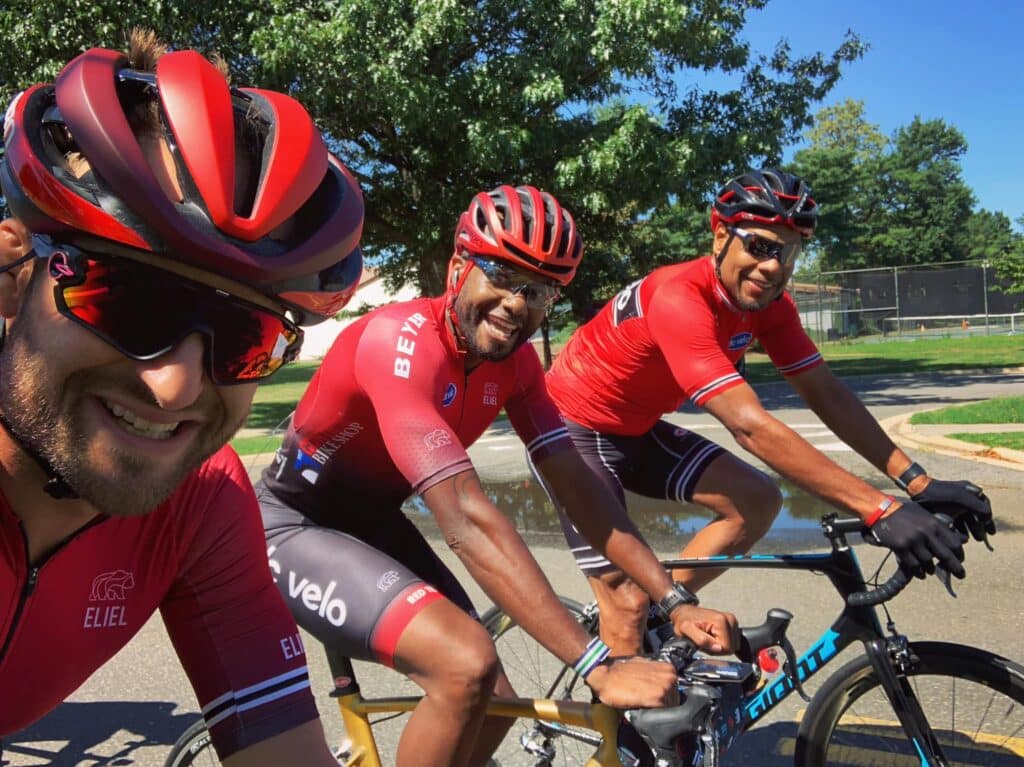
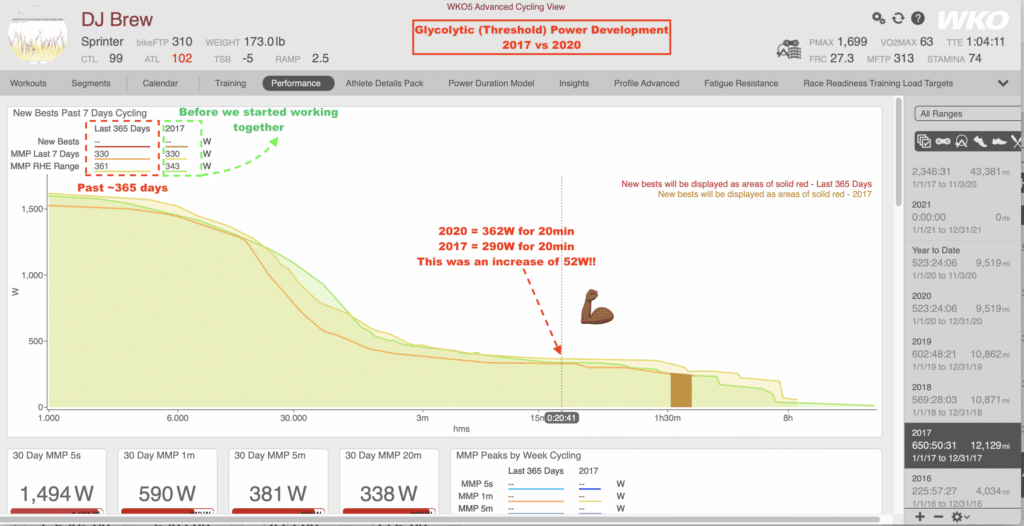
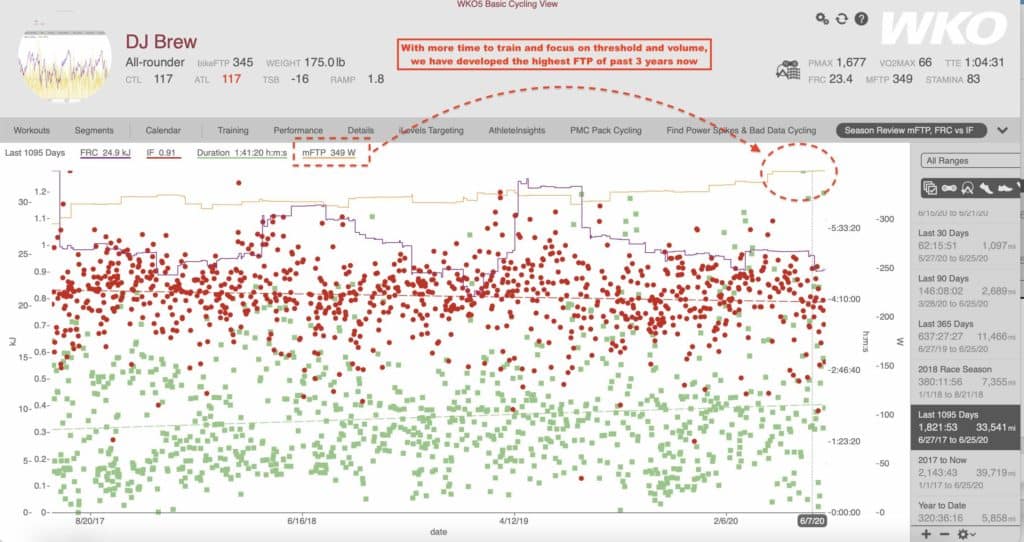
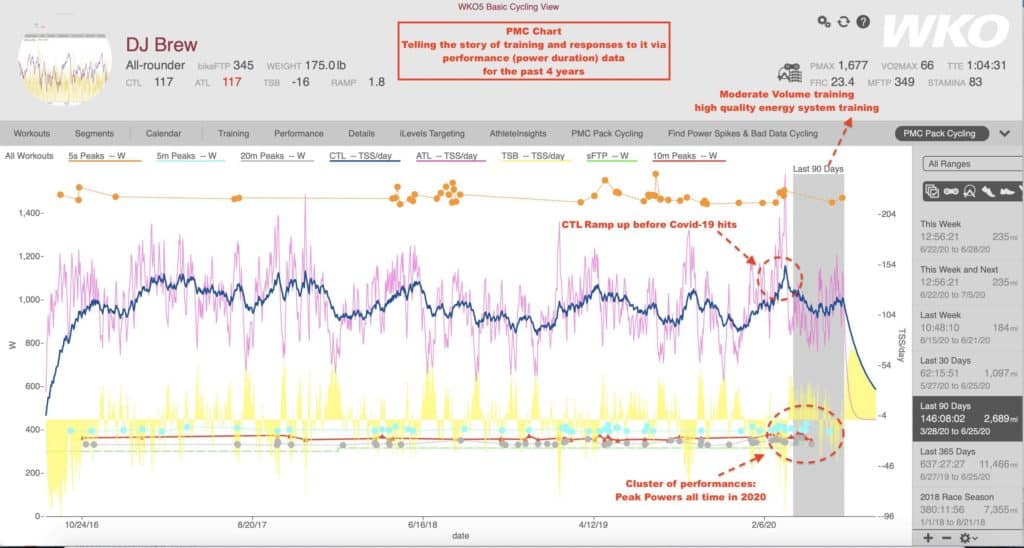
Comments 2
60 minute power and FTP are the same thing. There’s a 15 watt difference between reported increases in both, when there is no difference between FTP and 60 minute power.
Good to hear you fixed the Oreo craving.
For me, a “no sugar burn in the last 45 minutes of the ride” rule helped this in an amazing way.
Sprint finishes, on the other hand… make craving almost impossible!